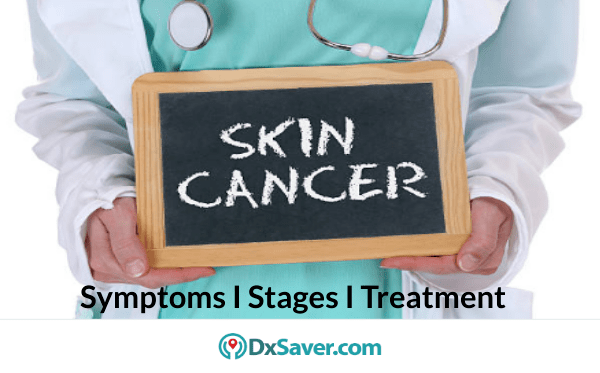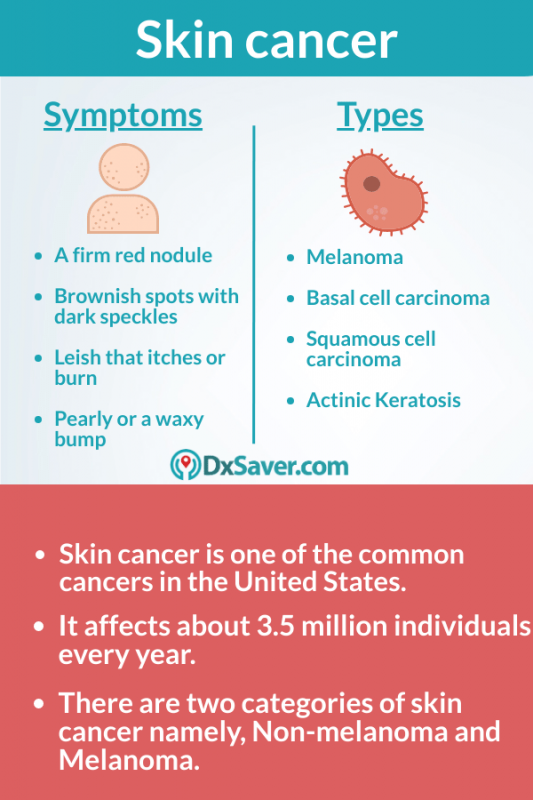
Skin cancer, the abnormal growth of skin cells that mostly develops on the skin caused by sun exposure. But this cancer may also occur on areas of your skin not ordinarily exposed to sunlight. Skin cancer is common cancer in the United States, affecting more than 3.5 million individuals every year. According to the Cancer Treatment Centers of America (CTCA), physicians treat cancer every day, giving them the knowledge and experience to help a person make informed decisions about care.
There are two categories of Skin cancer and are Non-melanoma and Melanoma skin cancers. Non-melanoma skin cancer such as basal cell carcinoma and squamous cell carcinoma, do not spread and may require little more than minor surgery or treatment. Whereas melanoma skin cancer, which accounts for about 2 percent of all skin cancers but is responsible for most skin cancer deaths, will spread through the lymphatic system or bloodstream to other organs.
In this article, we will cover related topics such as skin cancer symptoms, its stages, causes, types, treatments, who can easily get skin cancer, and its prevention.
- Skin cancer symptoms
- Skin cancer stages
- Skin cancer causes
- Types of skin cancer
- Complications of skin cancer
- Skin cancer treatment
- Prevention
Skin cancer symptoms
Skin cancer develops primarily on areas like the scalp, face, lips, ears, neck, chest, arms and hands, and on the legs in women. But it can also form on areas like your palms, beneath your fingernails or toenails, and also your genital area.
(i) Signs and symptoms of Basal cell carcinoma:
Basal cell carcinoma occurs in sun-exposed areas of your body, such as your neck and face.
Basal cell carcinoma may look like:
- Bleeding or scabbing sore that heals and appears again
- A pearly or a waxy bump
- A flat, flesh-colored, or brown scar
(ii) Signs and symptoms of Squamous cell carcinoma:
Squamous cell carcinoma occurs in sun-exposed areas such as your face, ears, and hands. Individuals with darker complexion are more likely to develop squamous cell carcinoma in areas that are not exposed to the sun.
Squamous cell carcinoma may look like:
- A firm red nodule
- A flat lesion with a scaly crusted surface
(iii) Signs and symptoms Melanoma
Melanoma can develop anywhere on your body, both in normal skin and in an existing mole that becomes cancerous. Melanoma mostly occurs on the face or the trunk of affected men. In women, this type of cancer develops on the lower legs. Melanoma in men and women may occur on skin that hasn’t been exposed to the sun. Melanoma symptoms may include:
- A large brownish spot with darker speckles
- A painful lesion that itches or even burns
- A mole that changes in color, size or that bleeds
- A lesion with an irregular border and portions that is red, pink, white, blue or blue-black in color
- Dark lesions on your palms, soles, fingertips, or toes, or even on mucous membranes lining your mouth, vagina, and anus
Skin cancer stages
To determine a skin cancer’s severity, your physician will identify how large the tumor is, if it has spread to your lymph nodes, or if it has spread to other parts of the body.
- Stage 0: The abnormal cells have not spread beyond the outermost layer of your skin, the epidermis at this stage
- Stage I: Cancer may have spread to the next layer of skin, the dermis at this point, but it is not longer than 2 centimeters.
- Stage II: At this stage, the tumor is larger than 2 centimeters, but it has not spread to nearby organs or lymph nodes.
- Stage III: Cancer has spread from the primary tumor to nearby tissue or bone during this stage, and it is larger than 3 centimeters.
- Stage IV: This is an advanced stage where cancer has spread beyond the primary tumor site to lymph nodes and bones. The tumor is also larger than 3 centimeters.
Skin cancer causes
Skin cancer is caused when errors occur in the DNA of skin cells. The mutations cause the cells to grow out of control and form a tumor.
1. Cells involved in skin cancer
Skin cancer begins in your skin’s top layer that is in the epidermis. The epidermis is a thin layer on your skin, a protective cover of skin cells that the body continually sheds. The epidermis consists of three types of cells and they include:
- Squamous cells: It lies below the outer surface of your skin and function as the skin’s inner lining.
- Basal cells: It produces new skin cells, stays beneath the squamous cells.
- Melanocytes: It produces melanin, the pigment that gives skin its normal color. It is located in the lower part of the epidermis. Melanocyte produces more melanin when you are exposed to the sun to help protect the deeper layers of the skin.
2. Ultraviolet light and other potential causes
Much of the damages in skin cells are caused by ultraviolet radiation from sunlight and also in the lights used in tanning beds. Other factors may also contribute to your risk of skin cancer, such as being exposed to toxic substances and having a condition that weakens your immune system in your body.
Types of skin cancer

There are two main types of skin cancer namely, keratinocyte carcinoma and melanoma. There are several other skin lesions that are considered as a part of a larger skin cancer umbrella. They are not taken as one of the types of skin cancer, but there is a high risk they become cancerous.
- Actinic keratosis: The red or pink patches on the skin are not cancerous, but they’re considered pre-cancer. These skin masses may develop into squamous cell carcinoma if left untreated.
- Basal cell carcinoma: This is the most common form of skin cancer, it accounts for 90 percent of skin cancer. They’re slow-growing tumors that most often occur on the head or neck.
- Squamous cell carcinoma: This type of skin cancer develops in the outer layers of your skin, and it’s more aggressive than basal cell carcinoma. It may appear as red, scaly lesions on the skin.
- Melanoma: Melanoma is a less common skin cancer, but it’s the most dangerous form of skin cancer. Though Melanoma makes up just one percent of skin cancers, it contributed to the majority of fatality related to skin cancer deaths every year.
Complications of skin cancer
Factors that increase the risk of skin cancer are:
- A history of sunburns: Having one or more blistering sunburns from your childhood or teenager increases the risk of developing skin cancer.
- Excessive sun exposure: Anyone who spends more time in the sun, is at a high risk of developing skin cancer, especially if the skin isn’t protected by sunscreen or covered using a cloth.
- Sunny or high-altitude climates: People who live in warm climates are exposed to heavy sunlight than are people who live in colder places. Living in places where sunlight is strongest, also exposes more radiation.
- Moles: People who have an excessive amount of moles or abnormal moles called dysplastic nevi are at high risk of developing skin cancer. These abnormal moles, which look irregular and are generally larger than the normal moles are more likely to become cancerous.
- Precancerous skin lesions: Skin lesions known as actinic keratoses may increase your risk of having skin cancer. These precancerous skin growths appear as rough scaly patches in color from brown to dark pink. They are common on the face, head, and hands of fair-skinned people.
Skin cancer treatment
The treatment plan recommended by your physician may depend upon different factors, like the size, location, type, and stage of the skin cancer. After considering these factors, your physician will recommend one or more of the following treatments:
- Cryotherapy: In this treatment, the growth of the cancer is frozen using liquid nitrogen and the tissue is destroyed as it thaws.
- Excisional surgery: The growth of the tumor and some of the healthy skin are cut out.
- Mohs surgery: In this treatment, the growth is removed layer by layer, and each layer is examined using a microscope until no abnormal cells grow.
- Curettage and electrodesiccation: A long spoon-shaped blade is used to scrape away the cancer cells at this treatment, and then the leftover cancer cells are burned using an electric needle.
- Chemotherapy: In this treatment, drugs are taken orally, and injected with a needle or IV line to kill the cancerous cells.
- Photodynamic therapy: Laser light and drugs are used to destroy the cancer cells in this treatment
- Radiation: This treatment is used to kill the cancer cells using high-powered energy beams.
- Biological therapy: This treatment helps in stimulating the immune system to fight the cancer cells.
- Immunotherapy: A cream is applied to the skin to stimulate your immune system and to kill the cancer cells.
Preventions
To lower the risk of skin cancer, avoid exposing your skin directly to sunlight and other sources of UV radiation. For example:
- Avoid tanning beds, sun lamps.
- Avoid direct sun exposure if the sun is strong, by staying indoors and in the shade during those times.
- Always Apply sunscreen and lip balm with a sun protection factor of 30 or higher to any exposed skin for at least 30 minutes before heading out.
- Wear a wide-brimmed hat, tightly woven fabrics when you’re out during daylight.
- Wear sunglasses that have 100 percent UVB and UVA protection.
It’s also important to regularly examine your skin to know new growths or spots. Tell your physician if you notice anything abnormal.
Other topics you may be interested in:-
- How much does the cancer test costs in the U.S?
- Signs and Symptoms of Oral Syphilis
- Lung Cancer causes & stages
- Breast Cancer symptoms, diagnosis & treatment
- Cost of Lymphocyte Blood Test in the US
- GGT, Gamma-GT Blood Test Cost in the US
- ANA Test Cost in the US
- Importance of hCG Qualitative Pregnancy Test
- Why is Gonorrhea STD called “The Clap”?
- Types of STDs that cannot be cured
- Is Itching a Symptom of STD?
- How Much Does At-Home Drug Test Kit Cost in the US?
- Herpes Vs. HPV: Differences, Symptoms, and Testing Cost
- What is throat cancer? Read more about its types, symptoms, and treatment
- Colon Cancer Stages, Early Symptoms, Causes & Treatment
- Symptoms of Pancreatic Cancer, Causes, Diagnosis & Treatment
- Is Mycoplasma Genitalium an STD?
- Oral STDs: Names, Symptoms, Treatment and Testing Cost
- Cost of Planned Parenthood STD Testing Vs. Other Labs/Clinics Near You
- Estradiol (E2) Hormone: Normal Levels, Importance in Women Fertility and Testing Cost